Signs You May Benefit from Duct Sealing
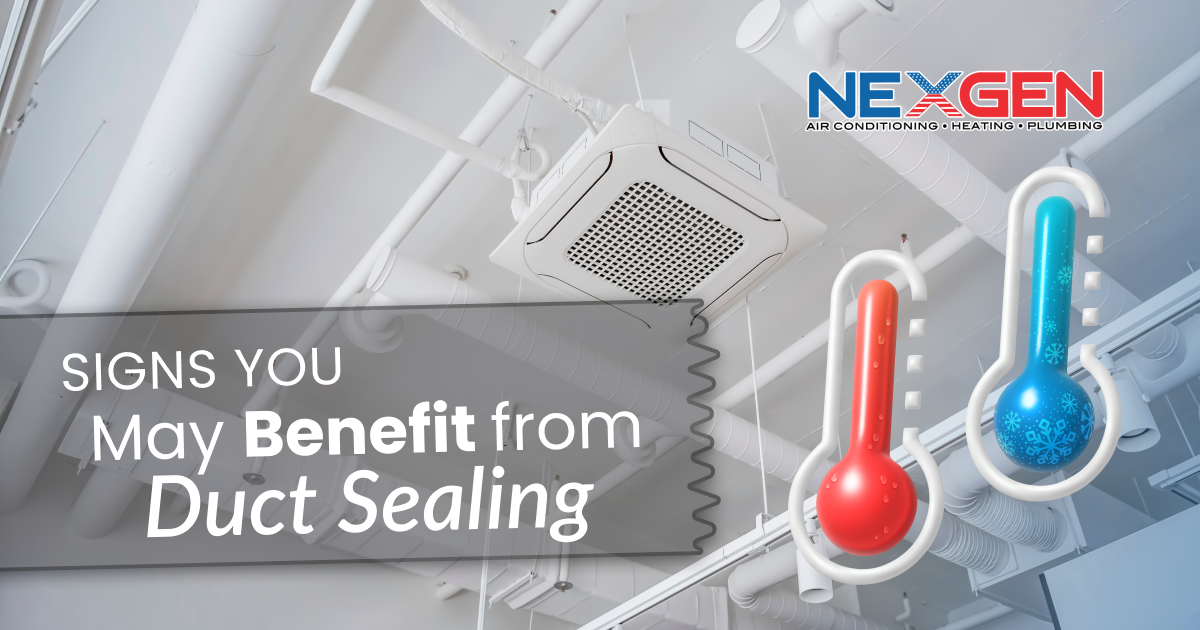
Sealing your air ducts can yield a range of benefits. Therefore, it’s important to recognize the signs of leaky ducts affecting your home. Air ducts are mostly in hard-to-access areas; you don’t usually see them. But some clues can indicate you may need duct sealing. Call an HVAC company if you notice:
Rooms Won’t Stay at the Right Temperature
When you walk through your home, do you notice one room is at a comfortable temperature, while another room may be too warm and another is too chilly? Leaky air ducts are a common cause of this problem. Holes, tears, and loose connections can prevent your central HVAC system from properly distributing air throughout your home.
Your Home Is Too Stuffy
Disruptions in airflow caused by leaky ducts can prevent your AC from circulating air, leading to stale and stuffy conditions. Resetting the thermostat won’t restore comfort. Neither will opening windows or running fans to increase ventilation. The problem won’t go away unless you address the underlying cause.
High Indoor Humidity
Ideally, the humidity level in your home should be between 30% and 50%. Any higher and it can get quite uncomfortable, and mold and bacteria can grow. That’s because air leaks can prevent the removal of water vapor from appliances and allow humid air in from outside. Duct sealing can resolve such issues and also prevent pest infestations and damage to electronics.
Unpleasant Odors
Your HVAC system should provide comfortable air that is odor-free. If the air doesn’t smell fresh and clean, duct sealing can help. Otherwise, air from the kitchen may reach other parts of your home, so cooking odors may be present in, for example, a bedroom. Unfiltered, polluted air may also enter from outside, so odors from vehicle exhaust, smoke, or wildlife may be noticeable indoors.
Symptoms of Poor Indoor Air Quality
Leaky ducts can decrease indoor air quality, which is problematic because pollutants can be many times more concentrated than outdoors. These can include pollen, mold spores, smoke, dust, chemicals, and volatile organic compounds. They may cause symptoms such as eye, nose, and throat irritation as well as headache, dizziness, coughing, sneezing, sinus congestion, or shortness of breath.
Doors Move On Their Own
A simple test can help determine if you need duct sealing. Close all exterior doors and windows, and close your interior doors. Turn on the central air handler and set it as you usually would. Then, open the interior doors just slightly. After a while, check whether any of them have moved, which can indicate an issue with air circulation or pressure caused by an air duct leak.
Unusual Noises from Air Ducts
Poorly sealed ducts can create loud noises as conditioned air is distributed throughout the system. If air is escaping, you may hear loud whistling or hissing sounds. These are an indication of air loss. The system will work harder to compensate. Therefore, if ignored, the noises can precede equipment damage and breakdowns.
Dust Blowing Out of the Registers
If dust blows from vents when you turn on the AC or furnace, your ductwork may be contaminated. This is often due to leaks that allow in dust and debris. Call an HVAC company to determine if duct sealing can resolve the problem.
Air Ducts Have Visible Damage
Check ducts in your basement, attic, or crawlspace. If an air duct has holes, it must be sealed or otherwise repaired. Kinked or tangled ductwork should also be fixed. A leak can cause changes in air pressure that pull on flexible ducts. High pressure in any part of the system can create leaks and make existing ones worse.
Higher Utility Bills During the Cooling or Heating Season
Energy bills can fluctuate seasonally. But the signs you may benefit from duct sealing are most evident in summer and winter when your heating and cooling system works hardest. Conditioned air may be escaping into parts of your house that don’t need it. Your HVAC unit will also struggle to manage the temperature if hot or cold air is leaking in from outside. Therefore, it’ll use more energy and cause your utility bills to increase.
Call NexGen for Professional Duct Sealing
We use the latest methods to seal air ducts in Southern California homes. Our fully licensed and insured technicians use advanced tools to check for and measure air loss and identify the location of leaks. Any type of leakage can be fixed to restore comfort, indoor air quality, and efficiency. We ensure you’ll see short-term and long-term savings. To schedule an evaluation and duct sealing, call (805) 301-6788 today.
Can Water Heater Repair Improve Efficiency?
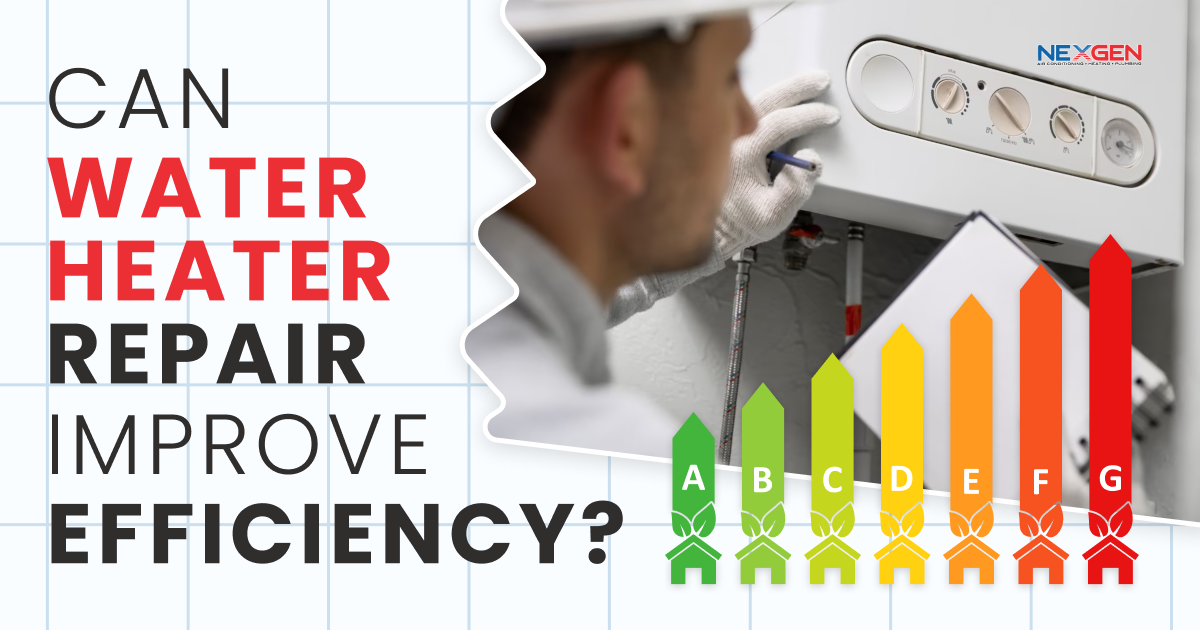
Improved efficiency is one of the greatest benefits of water heater repair. A technician can correct issues that cause the unit to be overworked and consume more energy. We’ll explain in more detail how repairing your water heater enables it to run more efficiently.
If your water heater needs to be repaired, its efficiency can be reduced due to these factors:
- The System Uses More Electricity: If a burner or heating element is malfunctioning or there’s a problem with an electrical connection, the unit may draw more power. Therefore, it becomes less energy efficient.
- An Increase in Water Usage: A struggling water heater will take longer to produce hot water. Therefore, you’ll leave a water faucet or fixture running longer, so water is wasted as you wait for it to become hot. Water heater repair can improve efficiency simply by reducing water consumption.
- A Heating Element Fails: An electric water heater usually has two heating elements. The second element will work twice as hard if the first breaks, causing the water heater to work less efficiently.
- Sediment in the Tank: A water heater in disrepair may have sediment in the tank. It typically originates from minerals in the water that crystalize and settle to the bottom. A buildup of sediment slows down the system and forces it to use more energy.
Water Heater Repairs Help Improve Energy Efficiency
A problem with a gas control, burner, or temperature-pressure relief valve can interfere with the unit’s water-heating ability. To restore performance, the technician can check for, find, and fix these issues. Replacing a small component is often enough. But a lack of hot water can also be due to a faulty thermostat. Call for help if adjusting the thermostat doesn’t increase or decrease water temperature.
However, if the tank is leaking, the water heater will have to be replaced. A leaky tank can significantly reduce efficiency. The system will also struggle to maintain the proper water temperature. Leaking water can increase your water bill and cause water damage as well.
Other Ways to Improve Water Heater Efficiency
Water heater repair comes in many forms, and maintenance is also important. You don’t have to wait for the water heater to break down for a technician to help it run more efficiently. Here are a few ways they can reduce energy consumption:
- Flush the Water Heater: You can follow the manufacturer’s instructions for draining sediment from the tank. Or, you can hire a technician who can quickly flush the tank to ensure the system runs at peak efficiency.
- Insulate the Tank and Pipes: Heat energy can escape through the tank and the piping connected to your water heater. By insulating the water storage tank and exposed piping, heat loss can be minimized. An insulation blanket is an easy and inexpensive way to protect the tank.
- Install a Volt Timer: A tank water heater works 24/7 to keep water hot. If you have an electric unit, a contractor can install a volt timer that turns it off at night when you are asleep. That’s one-third of the day the unit isn’t consuming energy.
Call NexGen for Water Heater Repair
Whether you need help with water heater repair or installation, you can trust NexGen for high-quality service. Our licensed, experienced technicians ensure water heaters in homes and businesses across Southern California work flawlessly. They can diagnose and fix any problem to improve your system’s performance and efficiency. To request help, book service online or call (833) 729-9735.
When to Schedule Home Air Duct Cleaning Services
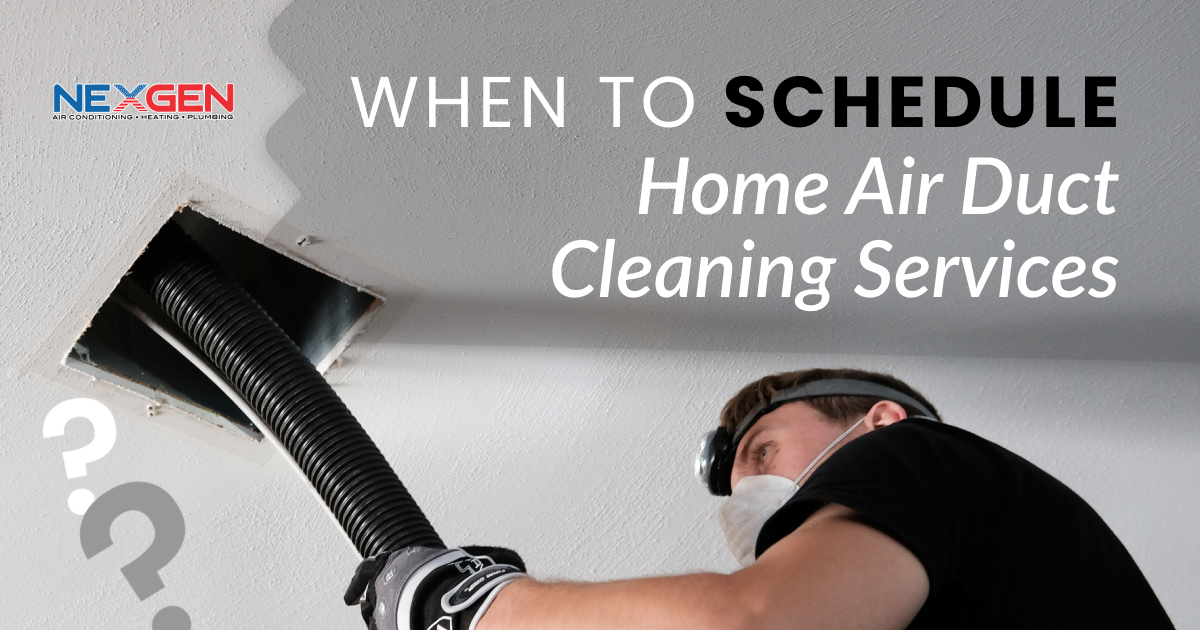
Homeowners concerned about indoor air quality are often unsure when to schedule an air duct cleaning service. Experts generally suggest it every three to five years. It’s not needed annually or more frequently like an AC tune-up, assuming you change the filters regularly and stay current with HVAC maintenance.
Many pollutants can be collected in your ductwork. Some, like smoke particles, volatile organic compounds, mold, chemicals, pesticides, etc., can be harmful. Contamination may also reduce HVAC performance and efficiency. Therefore, following our advice for scheduling air duct cleaning services can be beneficial.
When Is Best to Consider Air Duct Cleaning?
Since there’s no solid guideline on when to clean air ducts, it can be difficult to know when to call a contractor. But requesting the help of a ductwork professional is a good idea if:
- Your Ductwork Has Never Been Cleaned: Perhaps it’s been years, or decades, since your air ducts were installed, or they haven’t been professionally cleaned since you moved into your home. We suggest at least scheduling an inspection to see if your ducts are dirty.
- You’ve Recently Renovated/Remodeled Your Home: Dust and debris easily become airborne during renovation or remodeling work and can be blown into air ducts. Once inside, contamination can build up and recirculate.
- There’s Construction Near Your Home: Construction creates dust and particles that can find their way into your home and HVAC ducts. If your home is near a construction site, consider having your air ducts checked, and if necessary, cleaned.
- High Air Pollution Affects Your Area: Polluted air can contain particulates, smoke, and chemicals that can enter your home in many ways. If your city or community often experiences low air quality, consider more frequent duct cleaning.
- It’s a Season You Don’t Need the System: You can’t use your HVAC system while the duct cleaning company is working. Therefore, we recommend scheduling an air duct cleaning service in the spring or fall. It generally takes just a few hours and avoids being without your AC or heater during a hot or cold day.
Signs You Should Schedule Duct Cleaning Now
There are also more obvious signs that air duct cleaning would be beneficial. Schedule service with a local HVAC company if:
- Mold Is Growing Around Vents: If vents are moldy or have dark spots, mold is likely inside the ductwork and circulating. Left unchecked, mold growth can cause serious health issues and damage your HVAC system.
- Air Vents Are Dusty: Dusty vents can indicate widespread contamination in your ductwork and potential clogs. Call for help if dust and debris are collecting around air vents and are visible inside them.
- Odors Are Noticeable Throughout Your Home: Musty or stale odors can come from contaminated ductwork. Duct cleaning can remove the materials and substances that are causing them.
- There Are Insects or Rodents In Your Ducts: If you hear strange sounds or see insects, rodents, or their associated waste and debris, there’s a risk of serious air quality problems. Schedule a duct cleaning to remove pests and clean and sanitize your ducts.
- Your HVAC System’s Performance Declines: Call a ductwork professional if your home isn’t reaching the right temperature, airflow seems limited, or your HVAC unit runs constantly. They can clear clogged ducts to restore normal performance.
What Does the EPA Say?
The U.S. Environmental Protection Agency (EPA) admits cleaning air ducts doesn’t guarantee better indoor air quality. Pollutants can enter your home from many sources. Cleaning, cooking, and other activities can contribute to indoor air contamination. The EPA also notes the conditions in every home are different. So, whether your house is dusty, you suffer from allergies or unexplained symptoms, or odors are present, it may be helpful to inspect your air ducts. If they’re contaminated, air duct cleaning can resolve indoor air quality problems—if it’s done properly.
Call NexGen for Home Air Duct Cleaning Services in Southern California
A leading HVAC company in the region, NexGen performs air duct cleaning that can remove harmful particles, debris, and other pollutants. Our fully licensed, insured technicians use HEPA vacuums and deodorizing methods to clean and sanitize ductwork. In addition, we can clear blockages, seal leaks, and repair ductwork. For affordable air duct cleaning services in Los Angeles, Orange County, and surrounding areas, call (833) 729-9735 today.
What Does a Home Water Filtration System Cost?
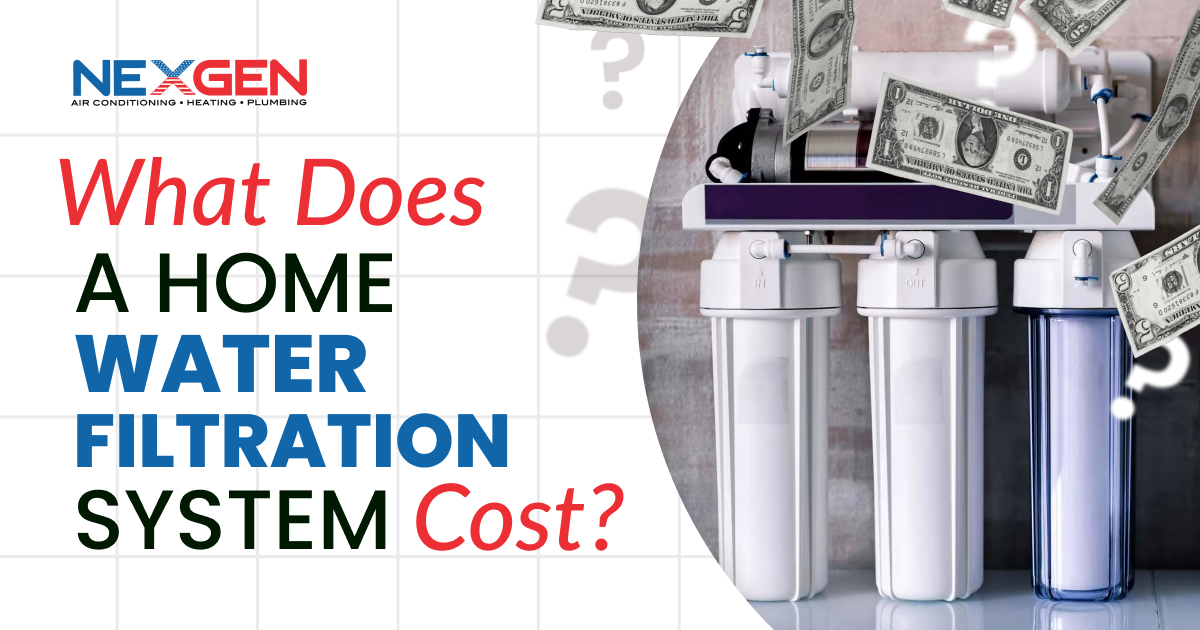
The cost of a home water filtration system varies considerably. According to HomeAdvisor, the national average is $2,050, with a range of $1,044 to $3,266.¹ However, HomeGuide estimates a whole home system can cost as much as $5,400 on average.² We’ll explain the factors that impact the total cost and some reasons why you should consider having NexGen install a home water filtration system for you.
How Is the Cost of a Water Filtration System Determined?
There are many types and sizes of water filtration systems. The type of system is only one cost factor but is perhaps the most significant one, so that’s where we’ll start.
Type of System
A water filtration system can serve a single fixture or purify the water supply for your entire home. The types of systems available include:
- Whole-House Water Filtration Systems: You may pay as little as $850 for a carbon, mineral, or sediment filter, but one with an ultraviolet (UV) light element can cost as much as $2,900. A system that also integrates a water softener can cost up to $5,400. Reverse osmosis filtration systems are the most expensive; they can cost from $4,800 up to $8,000. However, these can remove 99% of the contaminants in the water supply.²
- Under-Sink Water Filtration Systems: When you factor in equipment costs and labor, an under-sink unit ranges from $170 to $580 on average.² It may include up to three filters that allow for pre-filtering and water conditioning. Types of under-sink filters include reverse osmosis, carbon, alkaline, sediment, and heavy metal filters. They also include water softeners.
- Well-Water Filtration Systems: You may spend between $800 and $4,000 to install a well-water filtration system for your entire home.² Well water typically requires more filtration and local water quality has a significant impact on the price. Some of the technologies that may be used include UV light, distillation, reverse osmosis, chemical injection, particle, or activated carbon filtration.
- Rainwater Filtration System: Rainwater filtration systems can include distillation, reverse osmosis, or UV-light treatment. You’ll pay for pre-storage gutter and downspout collection/filtration and post-storage filtration. You’ll also have to purchase a storage reservoir. And the total cost also depends on whether this water will be used for drinking or gardening.
Treatment Method
As mentioned, a reverse osmosis system is the costliest but removes most metals, chemicals, and pathogens. Even for an under-sink unit, you may pay up to $950. Whole-house or under-sink UV water filtration units (which kill bacteria and viruses) can cost up to $1,500. Whole-house water softeners cost up to $2,500, and whole-house chemical injectors cost up to $1,500. A full water distillation system can be up to $3,600.²
Labor
The labor to install a whole-house system can cost from $200 to $600. In contrast, an under-sink filtration system ranges from $120 to $300.² A plumber, manufacturer-certified specialist, water-treatment installation company, or home improvement store contractor can install a home water filtration system. The cost of labor varies based on the installer’s rate and your geographical location.
Other Cost Factors
Aside from the type of system, treatment method, and labor, other factors that influence the cost of a home water filtration system include:
- Testing: Water testing by a professional helps determine the best type of system for your home. It costs from $100 to $300.²
- Equipment Brand: Higher-end, more efficient models with more features and greater contaminant-removal capabilities are more expensive.
- Plumbing Updates: If you need a 25+ foot pipe connection installed, it’ll cost $150 to $850. Plus, a plumber charges anywhere from $45 to $150 per hour.²
- Electrical Outlet: An electrical outlet must be placed within 10 to 15 feet of a whole-house filtration system’s tank. Installing one costs $150 to $350.²
- Permit: Depending on your location, a plumbing permit can cost $30 to $500, but one is necessary for installing a large water filtration system.²
- Replacement: You’ll be charged $40 to $300 to remove and dispose of an old water filtration system.²
- Drywall Repair: The cost to repair holes in sheetrock made to install water filtration lines ranges from $100 to $400.
Is a Home Water Filtration System Worth It?
Water filtration systems have many benefits. By investing in one, you’ll have safer drinking water, especially if you have an older home with lead pipes or use well water. A filtration system can remove chlorine and minerals, so tap water tastes better. It can also address hard water so there are fewer stains on dishes, clothes, and fixtures. Pipes and appliances are protected against mineral buildup and impurities, so they can last longer.
Contact NexGen Today
NexGen specializes in the installation and repair of home water filtration systems. Our fully licensed and insured technicians provide high-quality service to ensure your water supply is clean and safe. We service all makes and models of water filtration and cooling systems, while our team is experienced with HALO water filtration, purification, and conditioning equipment. Members of our X Protection Plan receive extended parts and labor warranty along with priority service. To learn more about our water filtration services or schedule free water testing, call (805) 301-6788 today.
Sources:
Can I Perform Ductless Mini-Split Maintenance Myself?
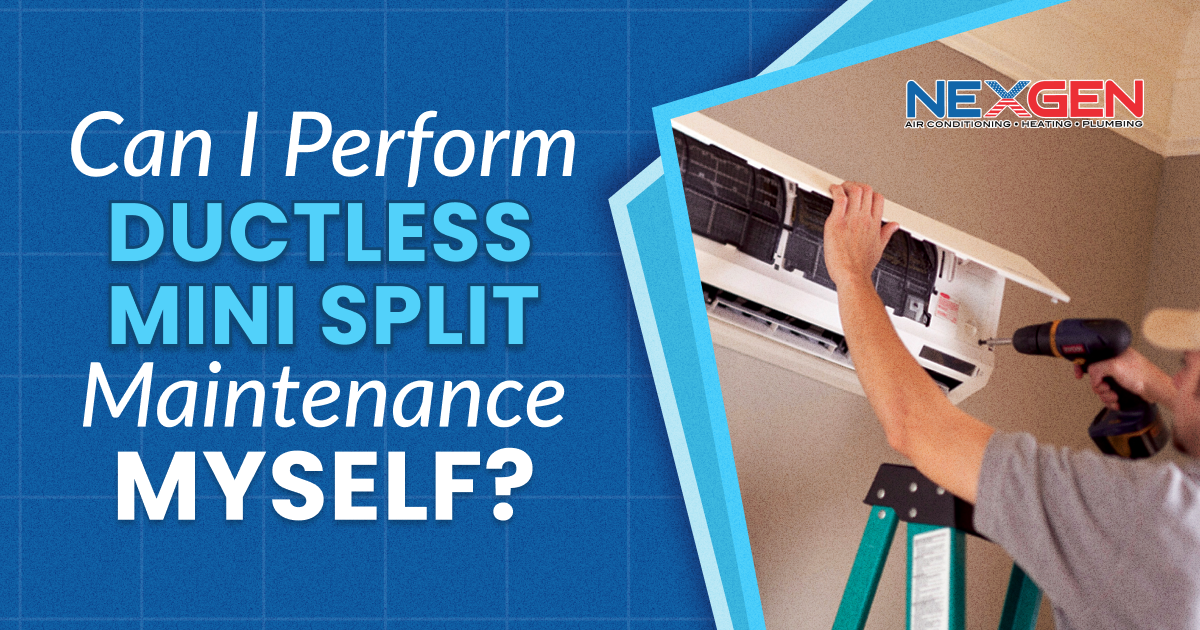
There are some types of ductless mini-split maintenance you can do yourself. While we recommend professional service twice a year to check electrical connections and for refrigerant leaks, drain hose blockages, faulty run capacitors, etc., we also encourage you to clean the system often. Here are some beneficial DIY maintenance tips to keep your ductless mini-split in top shape.
Clean or Change the Air Filters
Each indoor air handler has a filter. Depending on the model, the filter must be replaced or can be cleaned with a dry cloth before being re-inserted. Check the owner’s manual for the recommended interval and other instructions related to the model, but if your home is dusty or you have pets, check the filter more often. Otherwise, dust and dirt can build up in the system, causing it to work less efficiently and possibly leading to damage and a shortened lifespan.
Clean the Outside of Each Unit
If dust and dirt collect on the exterior of an air handler, particles can get inside and interfere with internal components. Dust the unit weekly to avoid any problems. This only requires a damp cloth and a gentle cleaning solution. Also, make sure the exterior of each vent is free from dust and dirt that can cause a clog.
Keep the Condenser Coils Clean
The condenser coils in the outdoor unit remove heat from the refrigerant. But if they’re dirty, heat transfer can be impeded and the system won’t work properly. Follow the care instructions in the owner’s manual to clean the coils. Generally, condenser coils can be sprayed clean with a garden hose, while the remaining debris can be removed with an AC coil cleaning brush. Also, check the blower assembly and fan wheel for dirt, and clean them as necessary. Just remember to turn the unit off before you get started.
Make Sure the System’s Pipes Are Clear
Dust and debris can block the drainage pipes between the indoor and outdoor units. The system will then struggle to maintain a comfortable temperature. To avoid trouble, clean the pipes by vacuuming the dirt out or clearing it with a brush. Call a professional if the clog is deep or you’re unable to clear the line.
Clear the Area Around Each Unit
Make sure no furnishings, objects, or clutter are blocking the ductless mini-split unit. If there’s not enough space around it, airflow can be restricted and dust can accumulate in the system. Ideally, large furniture, bookcases, and artwork should be kept at least four feet away from the unit.
Protect the Outdoor Unit in Winter
Snow, ice, and debris from trees can prevent the outdoor unit from running normally. Check it often during the colder months. Gently remove any snow and ice you find. Otherwise, it can cause serious damage that is expensive to repair. To prevent issues, mount the condenser unit above grade and place a protective plywood cover on top to avoid contact between the equipment and debris or moisture.
Schedule Ductless Mini-Split Maintenance with NexGen
Your mini-split system provides heating and cooling, so it should be inspected and cleaned by a professional twice a year. At NexGen, our licensed HVAC technicians will ensure your system gets the care it needs. Routine service and repair discounts are included in our maintenance plan. Continue reading to learn more about maintaining your ductless mini-split system; to schedule service, call (805) 301-6788 today.
A Guide to Plumbing System Types, Components, and Fixtures
 In this guide to plumbing systems, we’ll cover the various elements that supply, drain, and manage water in your house or building. A functioning system provides all the water you need and use. Most people don’t think about its complexity. It incorporates many parts and, which may seem surprising, multiple systems. We’ll now explain what your plumbing system is made of:
In this guide to plumbing systems, we’ll cover the various elements that supply, drain, and manage water in your house or building. A functioning system provides all the water you need and use. Most people don’t think about its complexity. It incorporates many parts and, which may seem surprising, multiple systems. We’ll now explain what your plumbing system is made of:
Types of Plumbing
There isn’t one but three systems that make up the plumbing in your home. Each fulfills a distinct function and, together, they allow for the delivery and removal of water and waste. These systems are:
Potable Plumbing
A potable plumbing system brings water into a structure for drinking, cleaning, and other purposes. It includes the main plumbing valve where you can turn off the water supply and the water meter that tracks water usage. Other components include long or short straight pipes, T-sections that direct water at right angles, elbows that provide directional adjustments, and brass and gate valves that help regulate water flow.
Sanitary Plumbing
A drainage system removes human waste and wastewater. To ensure continuous drainage, a sanitary plumbing system includes vents that maintain atmospheric pressure in the pipes. A gravity system (the most common) uses the ground’s slope to transport wastewater to the sewer. Alternatives include a low-pressure system that integrates a tank and pump and a vacuum system that operates on electricity and controls drainage in flat areas, seasonal properties, or structures built on reclaimed earth.
Stormwater Plumbing
A stormwater plumbing system protects your home from rainwater and melting snow and ice. In a gravity-fed system, pipes are sloped so water can flow smoothly. Pipe diameter is determined by the size of the drainage area and the average rainfall for a region. If there’s insufficient sloping, a pump-based system may be used; it collects rainwater in tanks and pumps it to a sewer or outside drainage system. A stormwater discharge and harvesting system transports water to a nearby body of water, like a lake, stream, or ocean.
Types of Pipes
Plumbing pipes are available in different materials and sizes. A plumbing system isn’t just one set of pipes. In addition to water supply and drainage lines, you also have separate pipes for hot and cold water. Plumbing pipes are available in different materials and sizes as well, depending on their function and the environment they’re used in.
Here’s a guide to plumbing pipes covering commonly used materials:
- Copper: Copper is the most common material for rigid pipes, as it’s corrosion-resistant, withstands high pressure and temperature extremes, and can last over 50 years. Flexible copper pipes are also available; they are malleable, so they can be bent to fit tight spaces. Copper pipes come in various thicknesses as well.
- Stainless Steel: Stainless steel pipe is expensive but resistant to corrosion and damage by extreme weather, human activities, and tree roots. Available in many sizes and lengths, it can be connected to other pipes with special couplings.
- PVC: Polyvinyl chloride (PVC) pipes can transport hot and cold water. Commonly used for plumbing fixture drain lines, PVC may also be used as the main water supply pipe. It’s also affordable, easy to install, resistant to blockages, and has some flexibility to tolerate high water pressure.
- CPVC: Chlorinated polyvinyl chloride (CPVC) pipes can withstand temperatures up to 200℉, but are costlier and can break down due to exposure to sunlight.
- Galvanized: Galvanized steel pipes may be found in older homes. They are prone to developing rust that can peel away and contaminate water. Therefore, these pipes are preferred for applications that don’t involve human consumption.
- Cast Iron: Rarely found in new construction homes, cast iron pipes are still used in parts of water distribution systems. They’re strong, heat-resistant, and dampen noise from moving water. Cast iron can be used for primary drainage and sewer lines.
- ABS: Resembling PVC, an acrylonitrile butadiene styrene (ABS) pipe is made of a thermoplastic resin. It’s most often used for interior vent and drain lines. Outdoor use is limited as high temperatures and UV rays can damage ABS.
- PEX: Cross-linked polyethylene (PEX) pipes are made of durable plastic and are often used to supply water. They are rigid yet flexible enough to route through walls, ceilings, and basements. PEX is inexpensive, long-lasting, and assembled without soldering.
Fixtures
Your plumbing fixtures are very much a part of your plumbing system. The bathroom has the highest concentration of plumbing fixtures, including toilets, sinks, tubs, and showers. Each has a system of pipes and fittings. The most complex is the toilet, which contains a bowl, water tank, fill valve, and a flush mechanism with a handle, flush valve, flapper, and other components. The toilet is also sealed to the floor drain by a gasket to prevent leakage (a gasket also seals the tank to the bowl).
In the kitchen, plumbing fixtures are also frequently used. Kitchen sinks can vary in size and complexity. Some have single- or double-bowl configurations. Depending on the model, it may include a spray hose, liquid soap dispenser, and water filtration system. A garbage disposal is also connected to your plumbing system.
The dishwasher is a convenient plumbing appliance. It includes a flexible hose to provide pressurized hot water and a flexible drain line that connects to the kitchen drain pipe. Also, refrigerators with water dispensers require a plumbing connection (usually a small, flexible copper or plastic tube).
Other elements worth mentioning in our guide to plumbing systems include:
- Basement Plumbing: Floor drains, washing machines, water heaters, and supply lines to furnace humidifiers and outdoor faucets are a few plumbing elements you’ll find in the basement.
- Outdoor Plumbing: Hose taps, yard irrigation systems, and septic systems are integral parts of your plumbing system where used.
- Roof Plumbing: In addition to a rooftop plumbing drain vent, gutters, downspouts, and roof flashing and capping are important for water drainage and protection.
Key Takeaways
As you can see, a plumbing system is quite complex. All parts must be correctly installed to ensure your safety, comply with building codes, and avoid water damage. Never try to do plumbing work yourself. It can be dangerous and costly. Always rely on an experienced and licensed professional who has the right tools and can anticipate any issues that may arise while doing plumbing work.
Call NexGen for Plumbing Installation and Repair
A full-service plumbing company in Southern California, NexGen helps choose and install piping and appliances and is available 24/7 to provide emergency repairs. Our fully licensed and insured technicians are knowledgeable, professional, and courteous. They can help with any project or issue.
We hope our guide to plumbing systems, components, and fixtures has helped you better understand how water supply and drainage work and why hiring a professional is so important. If you have further questions or need us for plumbing services, call (833) 729-9735 or contact us online.
7 Signs to Call a Sewer Drain Cleaning Service Now
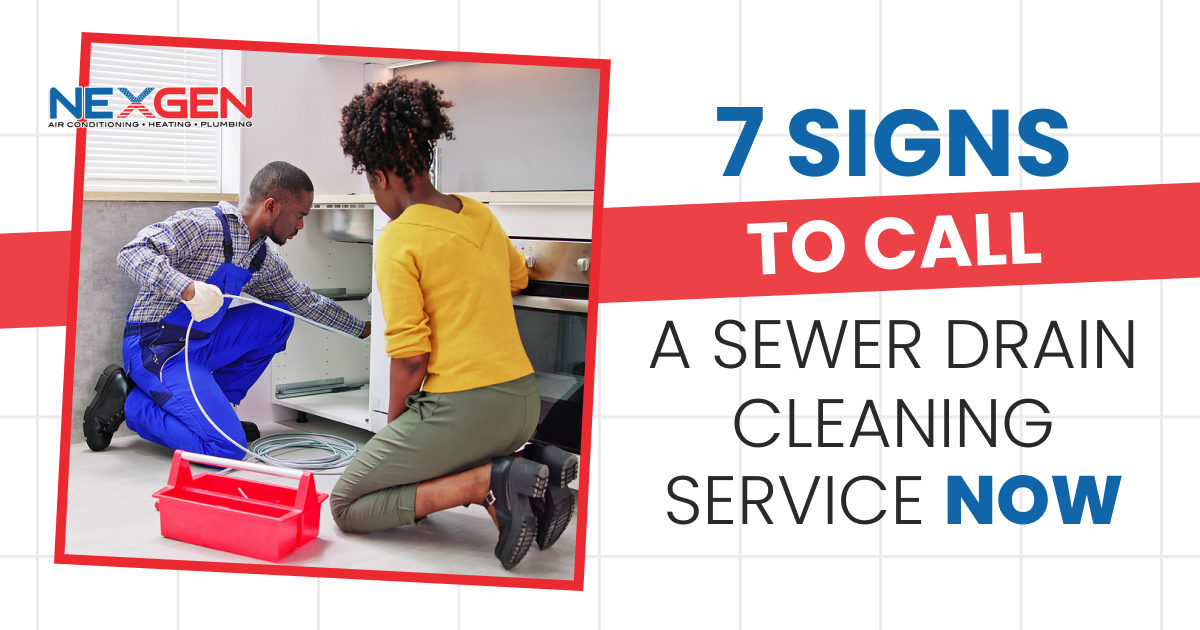
When there’s a drainage problem, it may be deeper than you think. A clogged sewer drain can cause wastewater to back up and overflow from any plumbing fixture. Fortunately, NexGen provides a sewer drain cleaning service to resolve or prevent messy, hazardous, or damaging situations. But you must know when to call so we can get there in time.
Here are seven signs you need a sewer drain cleaned now:
1. Multiple Fixtures Aren’t Working
A common sign of a clogged sewer drain is when more than one toilet clogs up. Toilets provide the most direct path to the sewer system. Thus, they’re the most reliable indicators of a sewer problem. Also, since shower and bathtub drains are lower than, for example, sinks, they’re more likely to be affected by clogged sewer lines.
2. Your Drains Are Slowing Up
If several drains are gradually getting slower, or the problem starts in one drain and spreads to others, it’s time to call a sewer drain cleaning service. As your main sewer line blocks off, water will take longer to go down. The sooner you call a professional, the more likely you can avoid a complete blockage or backup.
3. Drain Clogs Occur Frequently
The occasional kitchen or bathroom drain clog isn’t something to panic about. It’s usually easy to fix. But if you find yourself using plungers and drain cleaners more frequently, a sewer line clog or other problem may be the cause.
4. Plumbing Fixtures Are Acting Strangely
A clogged sewer drain can cause a tub or shower drain to overflow when you flush the toilet. The water from the toilet can’t drain, so it’ll back up at the lowest point. Or, the toilet may overflow when you run the washing machine. Another indication of trouble is when water in the toilet starts bubbling when you use the bathroom sink. It means air is trapped in the plumbing system, most likely due to a clogged sewer drain.
5. There’s a Pungent Odor In Your Home
Stronger and more persistent odors than usual from your toilet mean your sewer line needs to be serviced, especially if these smells are also emanating from your sink or shower drain. Exposure to sewer gas can cause eye irritation, coughing, and difficulty breathing. It can also lead to headaches, fatigue, dizziness, nausea, and trouble concentrating. Even a small amount of sewer gas can be hazardous. High levels can be fatal; if methane is present, sewer gas can also be explosive. Call for help!
6. Your Yard Is Soggy or Flooded
A wet yard isn’t usually a concern after it rains. But if there are wet spots during dry weather and all these spots align with the path of your sewer pipe, suspect a leak and call a plumber. A leak is possible whether there are sewage odors or not.
7. Water or Waste Back Up from the Clean-Out
Check the main line clean-out if you suspect a sewer line clog. Water should not flow to the top or spill out when you open the cap. If it has reached the top or you can see standing water inside, call a professional to address the clog.
Call NexGen for Sewer Drain Cleaning Service
No matter what’s clogging a sewer or other drain, our experienced plumbers can remove it and get your drainage system working again. We can use advanced snake equipment or a hydro jet machine at your sewer clean-out to resolve the issue. If the source is unknown, we’ll use a specialized fiber optic camera to identify it. To request 24/7 drain cleaning or other emergency plumbing services in Southern California, call (805) 301-6788.
6 Ways to Keep Your Brick House Cool in the Summer
 NexGen provides air conditioning services for all types of homes in Southern California. We know installing an AC requires considering a building’s size and construction materials. For example, brick is highly effective at holding heat. Therefore, it can be challenging to determine how to keep a brick house cool in the summer.[/caption]
NexGen provides air conditioning services for all types of homes in Southern California. We know installing an AC requires considering a building’s size and construction materials. For example, brick is highly effective at holding heat. Therefore, it can be challenging to determine how to keep a brick house cool in the summer.[/caption]
Brick houses get so hot because bricks are great at absorbing heat from the sun. This thermal energy is stored and released into the air and other building materials, providing a persistent source of heat that keeps your home uncomfortably warm. The thermal mass of brick, or its ability to store and release heat over time, is a downside compared to advantages such as its strength and durability.
How to Cool a Brick House
A brick home isn’t destined to always be hot. There are effective ways to control its temperature and allow your AC system to run more efficiently. These include:
Insulating Your Home
Whether installed during construction or a retrofit, insulation slows the transfer of heat between exterior and interior walls. Therefore, the amount of heat released to the interior is limited. Insulation will also prevent bricks from heating up. Your walls will then stay cooler and radiate less heat, thereby contributing to cooler indoor temperatures.
Block Direct Sunlight
Direct exposure to sunlight will counter any efforts you make to cool your brick home. To reduce the heating effect of sunlight, you can:
- Keep Your House Shaded: Plant trees, bushes, and shrubbery around the outside of your house, so sunlight won’t reach brick walls.
- Protect Your Windows: Double-glazed windows, blinds, and shades help block sunlight that can quickly heat your home. Also, keep windows closed to prevent hot air from entering.
- Block Sunlight: Awnings and external claddings prevent sunlight from reaching heat-absorbing bricks. Lighter-colored bricks and paints reflect sunlight and help limit heat transfer.
- Install Reflective Roofing Materials: Replace dark tiles or shingles with metal and reflective coatings. Lighter-colored materials will reduce your roof’s ability to absorb heat, keeping your home cooler.
Seal Cracks Around Doors and Windows
The smallest gaps can let in hot air and allow cool air to escape. Check for drafts around or near doors and windows. Small cracks can be sealed with caulking. An expandable foam spray can be used to seal larger gaps. Weatherstripping is also an effective seal. Call a professional if there are many large cracks or if you suspect structural damage.
Use Clay Bricks Instead of Concrete Bricks
If you’re constructing a brick home, choose clay which has a lower thermal mass than concrete. Clay absorbs heat more easily. But it also releases it faster rather than radiating heat throughout the night.
Use Fans Wherever Practical
Fans don’t cool the air, but they can help lower your body temperature. You can also place them wherever you need a cool space. Ceiling and portable fans are particularly effective for small rooms, whether your home is made of brick or not. You can use several of them for cost-effective cooling.
Install and Maintain an Air Conditioning System
Installing an air conditioner isn’t the cheapest option. But it is effective at providing cool air in a brick home. If you set the AC to a comfortable temperature early in the day, it will keep the bricks cool to start. Bricks retain cold quite well, especially if your home is well-insulated.
NexGen Can Help Keep Your Brick House Cool in the Summer
Our fully licensed and insured technicians install, repair, and maintain air conditioners throughout Southern California. We’ll evaluate your home to determine the best type of AC system for you. The systems we install and service include central units, ductless mini-splits, packaged units, and heat pumps. Our team can also install attic insulation and energy-efficient window coverings to help keep your home cool. To learn more, call (833) 729-9735.
Benefits of a Tankless Water Heater Flush Service
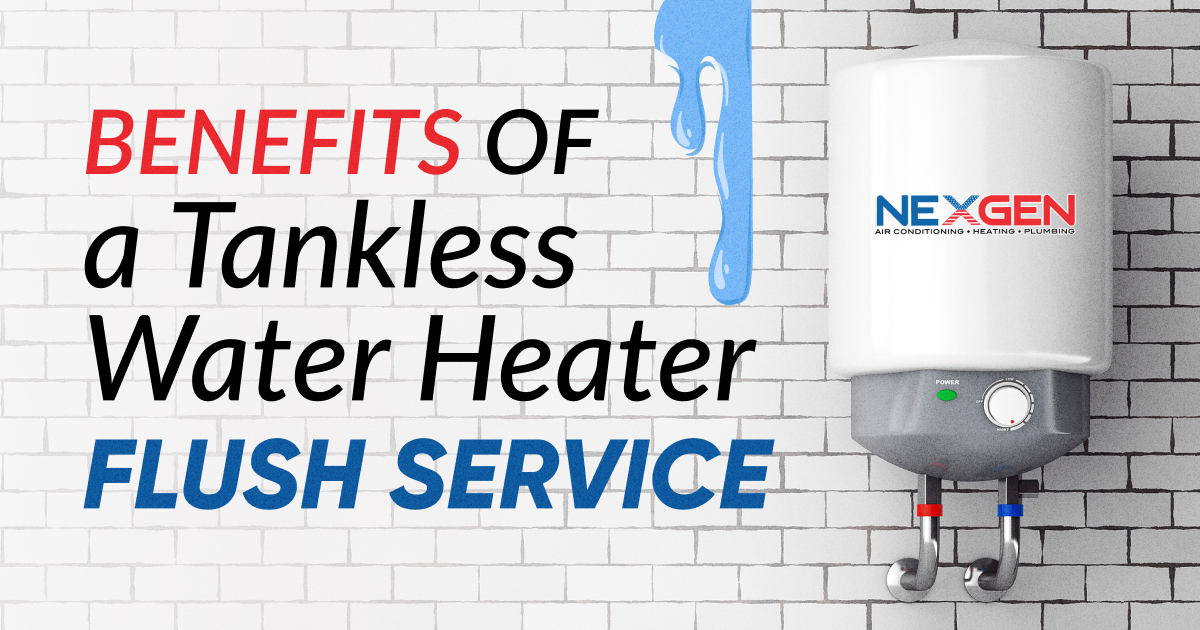
Flushing any water heater can improve its performance and reduce wear and tear. Tankless models are more efficient than traditional tank units; plus, their compact size allows you to fit them practically anywhere. But they still need a fair amount of upkeep. A tankless water heater flush service is a form of maintenance that’ll help get more from your system. The benefits of it include:
Remove Mineral Scale
Mineral deposits, along with sediment, are among the most detrimental issues for a water heater. Buildup reduces the unit’s operating capacity and can clog up water lines. It can lead to issues with water flow and water pressure. Flushing the tankless water heater of scale prevents these issues and enables the unit to work at full capacity.
Faster Heating
If a tankless water heater isn’t flushed regularly, it may take longer to provide hot water. Therefore, schedule maintenance if heating times are increasing. Mineral scale or obstructions may be impeding heat transfer and, in the process, you’ll use more water while waiting for it to reach the right temperature.
Reduced Noise
Noise from a tankless water heater often comes from sediment and mineral buildup inside it. The water flow must move past obstructions to reach its destination. Don’t wait for the noise to go away on its own. Once it does, this means the buildup has solidified and water cannot pass through.
Lower Utility Bills
Investing in a tankless water heater flush service can lower your utility bills. Since the unit can work more efficiently, it won’t require as much power to run. You’ll also use less water while waiting for the temperature to increase. Water and gas or electric bills (depending on the type of unit) should be noticeably lower after the unit is flushed.
Increased Longevity
Flushing a tankless water heater reduces wear and tear and can prevent system failure. The cost of a system flush is much less than premature replacement. You can extend the life of your water heater by as much as several years by scheduling regular flushes.
Improved Water Quality
Buildup in your water heater can lead to sediment, discoloration, odors, and other water quality issues. By flushing residue that builds up inside, you can avoid or resolve these. It can improve the overall quality of your home water supply.
Continued Warranty Protection
Depending on your tankless water heater’s warranty, it may require routine maintenance to stay valid. Also, it may not cover failure that occurs due to sediment or mineral scale buildup. You can maintain warranty protection by having a plumber flush your water heater professionally and provide the documentation proving they did so.
How Often to Flush a Tankless Water Heater
Most professionals suggest flushing a tankless water heater every year. Others suggest doing so once every two years or, in areas with hard water, every six to nine months. You can also flush an older unit that hasn’t been fully maintained. It can restore efficiency and protect the unit from damage.
However, we recommend not waiting too long between each tankless water heater flush service. Over time, scale buildup can weaken and eat through pipes. Holes can form and cause leaks in pipes within and attached to the water heater. The best option is to have a qualified plumber inspect the unit, determine if it can be flushed, and perform the necessary services.
Schedule a Tankless Water Heater Flush Service with NexGen
At NexGen, we are experienced with installing, repairing, and maintaining tankless water heaters. Our technicians are fully licensed and insured. By joining our X Protection Plan, you’ll receive priority service and perks such as an annual tankless water heater flush and inspection. To learn more or request maintenance, book online or call (833) 729-9735 today.
What Should I Pay for Hydro Jetting Services Near Me?
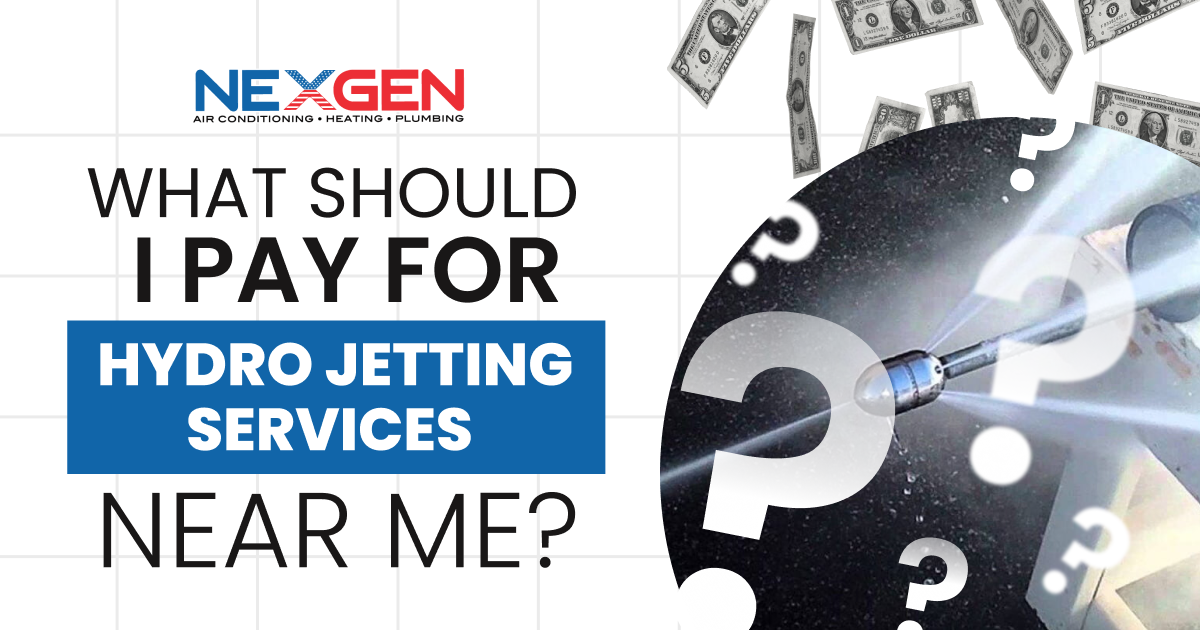
To understand the value of hydro jetting, let’s look at the benefit of no digging. It’s a trenchless method. Therefore, the time and expense of excavating sewer pipes, along with the labor involved, are avoided. But nationally, the average cost of hydro jetting is $700 (as of 2023). The estimate for a simple job may be lower, but on the high end, the service can cost as much as $1,100 for a residential customer.¹
However, commercial hydro jetting can cost as much as $3,300.¹
How Does Hydro Jetting Compare to Sewer Line Snaking?
Hydro jetting has similarities to snaking a sewer line, which averages $200 to $600.¹ A sewer snake is a long flexible metal rod. It’s inserted into the cleanout and, once in the pipe, a machine is activated to rotate the rod and sharp blades that cut through debris, tree roots, or whatever else is causing the clog. A hydro jetting hose is connected to a machine on one end, while the other end is inserted into the pipe. Long and flexible, it pumps a powerful jet of clean water into the sewer line to clear a blockage.
How Is the Cost Determined?
Hydro jetting isn’t typically priced at a flat rate. The factors that influence how much you pay for it include
- The Extent of the Clog: Generally, the more severe the clog, the longer it takes to clean the sewer line. Therefore, the higher the cost. The process usually takes under two hours, but treating an entire line can take longer. If you have a severe clog, your plumber may suggest scheduling hydro jetting as preventative maintenance. It can avoid more costly repairs.
- Access to the Pipe/Clog: The plumber will usually access the sewer line via the cleanout, which has a removable cap. If the cleanout is easy to get to, hydro jetting may cost less. But if the cleanout is in a basement, crawlspace, or another hard-to-reach area (or your property has no cleanout), you’ll pay more for the service. Fortunately, most cleanouts are located outside the home near landscaping or the foundation, driveway, or curb.
- Sewer Line Video Inspection: A video inspection allows a plumber to view the pipe from the inside and see signs of damage or leakage. Pipe sections that need repair are mapped, so a crew knows where to work. The video feed also helps determine if the pipe is strong enough for hydro jetting. Depending on a few factors, a sewer line video inspection can cost $300 to $1,200 (in addition to the cost of hydro jetting).¹
- Repairs: If your sewer line needs to be repaired or replaced, you may pay an additional $2,000 to $15,000.¹ The cost depends on how much pipe must be replaced, the depth of the sewer line, and other factors. Preventative maintenance can protect your sewer line and avoid these costs, potentially saving you tens of thousands of dollars and the aggravation of persistent sewer clogs.
Why Hire a Hydro Jetting Professional
A professional plumber can safely hydro jet a sewer line or determine if the pipe is too old, damaged, or weakened to hold up. It’s a fast way to clear minor clogs and residual debris consisting of a wide range of materials. Wastewater is dirty and contains harmful bacteria; a hydro jetting professional helps eliminate these organisms, the odors they produce, and the risk of infection.
Call NexGen for Hydro Jetting Services Near You
Hydro jetting can remove stubborn clogs and keep your sewer line in top condition. NexGen uses industrial-grade machines that generate pressures of up to 4,000 psi to break up virtually any clog. To schedule hydro jetting services in Southern California to clear a blockage, fix a backed-up sewer, or maintain the line, call (805) 301-6788.
Source:


















